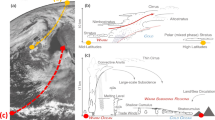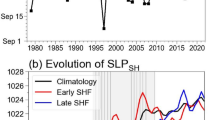Summary
The boundary-layer structure of the Elqui Valley is investigated, which is situated in the arid north of Chile and extends from the Pacific Ocean in the west to the Andes in the east. The climate is dominated by the south-eastern Pacific subtropical anticyclone and the cold Humboldt Current. This combination leads to considerable temperature and moisture gradients between the coast and the valley and results in the evolution of sea and valley wind systems. The contribution of these mesoscale wind systems to the heat and moisture budget of the valley atmosphere is estimated, based on radiosoundings performed near the coast and in the valley.
Near the coast, a well-mixed cloud-topped boundary layer exists. Both, the temperature and the specific humidity do not change considerably during the day. In the stratus layer the potential temperature increases, while the specific humidity decreases slightly with height. The top of the thin stratus layer, about 300 m in depth, is marked by an inversion. Moderate sea breeze winds of 3–4 m s−1 prevail in the sub-cloud and cloud layer during daytime, but no land breeze develops during the night.
The nocturnal valley atmosphere is characterized by a strong and 900 m deep stably stratified boundary layer. During the day, no pronounced well-mixed layer with a capping inversion develops in the valley. Above a super-adiabatic surface layer of about 150 m depth, a stably stratified layer prevails throughout the day. However, heating can be observed within a layer above the surface 800 m deep. Heat and moisture budget estimations show that sensible heat flux convergence exceeds cold air advection in the morning, while both processes compensate each other around noon, such that the temperature evolution stagnates. In the afternoon, cold air advection predominates and leads to net cooling of the boundary layer. Furthermore, the advection of moist air results in the accumulation of moisture during the noon and afternoon period, while latent heat flux convergence is of minor relevance to the moisture budget of the boundary layer.
Similar content being viewed by others
References
RG Barry (1992) Mountain weather and climate Routledge London 402
Caughey SJ (1982) Observed characteristics of the atmospheric boundary layer. In: Nieuwstadt FTM, van Dop H (eds) Atmospheric turbulence and air pollution modelling. Reidel, Dordrecht, Holland, pp. 107–58
C Freytag (1985) ArticleTitleMERKUR-results: aspects of the temperature field and the energy budget in a large alpine valley during mountain and valley wind Contr Atmos Phys 58 458–476
M Gamo (1996) ArticleTitleThickness of the dry convection and large-scale subsidence above deserts Bound Layer Meteorol 79 265–278 Occurrence Handle10.1007/BF00119441
JR Garratt (1994) The atmospheric boundary layer Cambridge University Press Cambridge 316
J Grunwald N Kalthoff U Corsmeier F Fiedler (1996) ArticleTitleComparison of areally averaged turbulent fluxes over non-homogeneous terrain: results from the EFEDA-field experiment Bound Layer Meteorol 77 105–134 Occurrence Handle10.1007/BF00119574
B Hennemuth (1985) ArticleTitleTemperature field and energy budget of a small alpine valley Contr Atmos Phys 58 545–559
B Hennemuth I Neureither (1986) ArticleTitleDas Feuchtefeld in einem alpinen Endtal Meteorol Rdsch 39 233–239
TW Horst JC Doran (1986) ArticleTitleNocturnal drainage flow on simple slopes Bound Layer Meteorol 34 263–286 Occurrence Handle10.1007/BF00122382
N Kalthoff V Horlacher U Corsmeier A Volz-Thomas B Kolahgar H Geiß M Möllmann-Coers A Knaps (2000) ArticleTitleInfluence of valley winds on transport and dispersion of airborne pollutants in the Freiburg-Schauinsland area J Geophys Res 105 1585–1597 Occurrence Handle10.1029/1999JD900999
N Kalthoff I Bischoff-Gauß M Fiebig-Wittmaack F Fiedler J Thürauf E Novoa C Pizarro R Castillo L Gallardo R Rondanelli M Kohler (2002) ArticleTitleMesoscale wind regimes in Chile at 30° S J Appl Meteorol 41 953–970 Occurrence Handle10.1175/1520-0450(2002)041<0953:MWRICA>2.0.CO;2
N Kalthoff M Fiebig-Wittmaack C Meißner M Kohler M Uriarte I Bischoff-Gauß (2006) ArticleTitleThe energy balance, evapo-transpiration and nocturnal dew deposition of an arid valley in the Andes J Arid Environ 65 420–443 Occurrence Handle10.1016/j.jaridenv.2005.08.013
M Kossmann F Fiedler (2000) ArticleTitleDiurnal momentum budget analysis of thermally induced slope winds Meteorol Atmos Phys 75 195–215 Occurrence Handle10.1007/s007030070004
M Kossmann AP Sturman P Zawar-Reza HA McGowan AJ Oliphant IF Owens RA Spronken-Smith (2002) ArticleTitleAnalysis of the wind field and heat budget in an alpine lake basin during summertime fair weather conditions Meteorol Atmos Phys 81 27–52 Occurrence Handle10.1007/s007030200029
Kraus H (1970) Die Energieumsätze in der bodennahen Atmosphäre. Offenbach a. M., Berichte des Deutschen Wetterdienstes N 117, 43 pp
T Kuwagata J Kondo M Sumioka (1994) ArticleTitleThermal effect of the sea breeze on the structure of the boundary layer and the heat budget over land Bound Layer Meteorol 67 119–144 Occurrence Handle10.1007/BF00705510
B Mayer A Kylling (2005) ArticleTitleTechnical note: the libRadtran software package for radiative transfer calculations – description and examples of use Atmos Chem Phys 5 1855–1877 Occurrence Handle10.5194/acp-5-1855-2005
HA McGowan AP Sturman (2005) ArticleTitleAtmospheric boundary layer development over a narrow coastal plain during onshore flow Meteorol Z 14 3–14 Occurrence Handle10.1127/0941-2948/2005/0014-0003
A Miller (1976) The climate of Chile W Schwerdtfeger (Eds) Climates of Central and South America SeriesTitleWorld survey of climatology NumberInSeries12 Elsevier Scientific Publ. Amsterdam 113–145
B Neininger (1982) ArticleTitleMesoklimatische Messungen im Oberwallis Ann Meteor N F 19 105–107
S Olivares F Squeo (1999) ArticleTitlePatrones fenológicos en especies arbustivas del desierto costero del norte-centro de Chile Revista Chilena de Historia Natural 72 353–370
J Rutllant P Ulriksen (1979) ArticleTitleBoundary-layer dynamics of the extremely arid northern part of Chile: the Antofagasta field experiment Bound Layer Meteorol 17 41–55 Occurrence Handle10.1007/BF00121936
RS Schemenauer P Cereceda N Carvjal (1987) ArticleTitleMeasurements of fog water deposition and their relationships to terrain features J Clim Appl Meteorol 26 1285–1291 Occurrence Handle10.1175/1520-0450(1987)026<1285:MOFWDA>2.0.CO;2
RS Schemenauer PH Fuenzalida P Cereda (1988) ArticleTitleA neglected water resource: the Camanchaca of South America Bull Amer Meteor Soc 69 138–147 Occurrence Handle10.1175/1520-0477(1988)069<0138:ANWRTC>2.0.CO;2
F Squeo R Osorio G Arancio (1994) Flora de Los Andes de Coquimbo: Cordillera de Doña Ana Ediciones Universidad de La Serena La Serena 168
R Steinacker (1984) ArticleTitleArea-height distribution of a valley and its relation to the valley wind Contr Atmos Phys 57 64–71
RB Stull (1988) Introduction to Boundary Layer Meteorology Kluwer Academic Press Dordrecht 666
I Vergeiner E Dreiseitl (1987) ArticleTitleValley winds and slope winds – observations and elementary thoughts Meteorol Atmos Phys 36 264–286 Occurrence Handle10.1007/BF01045154
T Warner (2004) Desert meteorology Cambridge University Press Cambridge 595
Weischet W (1996) Regionale Klimatologie, Teil 1. Die Neue Welt: Amerika, Neuseeland, Australien. Teubner, Stuttgart, 468 pp
Whiteman CD (1990) Observations of thermally developed wind systems in mountainous terrain. In: Blumen (ed) Atmospheric processes over complex terrain. Meteorological monographs 23. Amer Meteor Soc, Boston, pp. 5–42
CD Whiteman TB McKee JC Doran (1996) ArticleTitleBoundary layer evolution within a canyonland basin. Part I: Mass, heat, and moisture budgets from observations J Appl Meteorol 35 2145–2161 Occurrence Handle10.1175/1520-0450(1996)035<2145:BLEWAC>2.0.CO;2
CD Whiteman S Zhong X Bian JD Fast JC Doran (2000) ArticleTitleBoundary layer evolution and regional-scale diurnal circulations over the Mexico basin and Mexican plateau J Geophys Res 105 10081–10102 Occurrence Handle10.1029/2000JD900039
A Zangvil (1996) ArticleTitleSix years of dew observations in the Negev Desert, Israel J Arid Environ 32 361–371 Occurrence Handle10.1006/jare.1996.0030
Author information
Authors and Affiliations
Corresponding author
Additional information
Correspondence: Norbert Kalthoff, Institut für Meteorologie und Klimaforschung, Universität Karlsruhe/Forschungszentrum Karlsruhe, Postfach 3640, 76021 Karlsruhe, Germany
Rights and permissions
About this article
Cite this article
Khodayar, S., Kalthoff, N., Fiebig-Wittmaack, M. et al. Evolution of the atmospheric boundary-layer structure of an arid Andes Valley. Meteorol Atmos Phys 99, 181–198 (2008). https://doi.org/10.1007/s00703-007-0274-3
Received:
Accepted:
Published:
Issue Date:
DOI: https://doi.org/10.1007/s00703-007-0274-3




